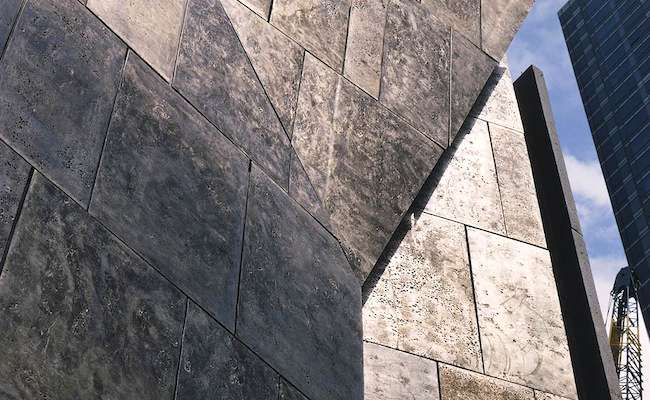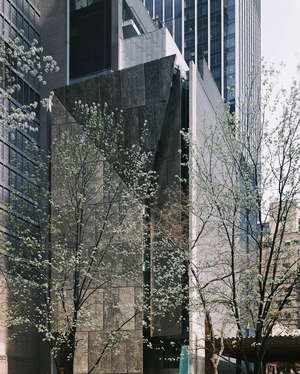
Photo © MichaelMoran/OTTO
In this issue of RECORD, we explore works of architecture as urban catalysts—buildings that raise the stakes for design in their neighborhoods while successfully engaging the surrounding context.

|
|
Photo © MichaelMoran/OTTO
|
So it was a brutal irony to learn, as we were closing the following pages, that the Museum of Modern Art in New York plans to demolish its next-door neighbor, the stunning former home of the American Folk Art Museum, designed by Tod Williams Billie Tsien Architects, the 2013 AIA Architecture Firm Award recipient.
Williams and Tsien's museum, which opened in 2001 (RECORD, May 2002), is the epitome of an urban catalyst: a beautiful and inventive jewel of a building that enriched its streetscape and the city when it opened in the dark days not long after the 9/11 attacks. Its modest scale (the 30,000-square-foot structure sits on a site just 40 feet wide) was humane, a reminder of the townhouses that once lined that Midtown Manhattan block. Its dazzling facade of pockmarked bronze-alloy panels was a tour de force of contemporary craftsmanship—an artwork that begged to be touched.
The story of the Folk Art Museum's fate is full of sad ironies, as I recently wrote on archrecord.com. The most obvious is that MoMA was the first museum to establish a department of architecture and design, and is now both judge and executioner of an acclaimed modern building by one of America's most distinguished practices.
When the small museum opened, MoMA, on its eastern edge, was in the throes of constructing a mammoth expansion, completed in 2004. Williams and Tsien had been invited to submit a design for the new MoMA (irony no. 2), but were beaten by the minimalist scheme of Yoshio Taniguchi. Another contender in that competition, Rem Koolhaas and his firm OMA, tweaked MoMA's expansionist ambitions by putting the words “MoMA, Inc.” on their proposed plans (irony no. 3)—and, of course, OMA lost MoMA.
Unfortunately, the Folk Art Museum had overreached in creating a new facility, and in 2011 its board was forced to sell the building to meet debt obligations of nearly $32 million. MoMA was an eager buyer. (It got it for less than the price of a good Picasso!) Its director, Glenn Lowry, had once tried to swap the Folk Art Museum's site for property that MoMA owned just west of it, to create a contiguous plot for the museum in the future, but the Folk Art folks turned the deal down (irony no. 4).
So when MoMA bought the Williams and Tsien museum last year, it was not adding a building to its collection so much as acquiring a coveted piece of real estate. MoMA has failed in its stewardship of a work of modern architecture at least once before: after the widow of Gordon Bunshaft bequeathed his East Hampton beach house to MoMA, the museum sold it to Martha Stewart, who gutted it and later sold the unfinished shell. It has since been demolished (irony no. 5).
At first, there was hopeful speculation that MoMA might keep the Williams and Tsien museum as a home for its department of architecture and design. But much bigger plans got in the way. MoMA had sold its last piece of land in 2007 to the Hines company (including that lot on the west side of the Folk Art site), where the developer will construct a skyscraper designed by Jean Nouvel. It will include galleries for MoMA. The museum maintains that the William and Tsien building can't be adapted as a link between the current MoMA building and the Nouvel structure because of varying floor heights. In addition, according to the New York Times, MoMA officials said the opaque bronze facade is “not in keeping with the glass aesthetic of the rest of the museum.” (We can't help but wonder how that argument will sound when Nouvel's macho-man behemoth is breathing down on MoMA's smooth ladylike skin.)
MoMA's board chairman, Jerry I. Speyer, may not miss the Williams and Tsien museum as much as the rest of us because he gets to go home every night to one of their buildings, a Manhattan townhouse that he and his wife commissioned from the architects (irony no. 6).
If only the process that led to this decision had been as transparent as that glass aesthetic that MoMA loves. But it all took place behind closed boardroom doors, not unlike the controversial plans unveiled by the New York Public Library to radically alter part of its interior with a design from Foster + Partners.
Like the library, MoMA is in both the real-estate and the culture business. Yes, these are nonprofit institutions with heavy financial burdens in an era of ever-diminishing government support. But they—and their buildings—are part of the public realm. Whether we borrow books or look at art, we are citizens who support them, through our taxes and through tax relief. Not every significant building can remain standing in perpetuity—but decisions to destroy or alter key works of architecture should be made transparently and openly. And the voices of the public should be heard.




Post a comment to this article
Report Abusive Comment